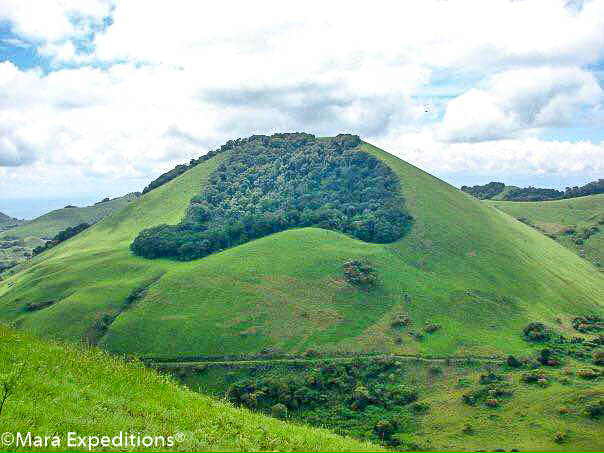Chyulu Hills in south-eastern Kenya is a volcanic landscape, a wildlife corridor, and a rich biodiversity with stunning flora and fauna.
Chyulu Hills Overview.
The Chyulu Volcanic Hills are a mountainous range located in southeastern Kenya. The volcanic range stretches across the border between Makueni County and Kajiado County. These hills are part of the larger East African Rift System and are relatively young, with volcanic activity. The blast occurred as recently as 240 years ago. It forms a 100-kilometre-long volcanic field elongated in a NW-SE direction. Its highest peak is 2,188m above sea level. Kibwezi town is located 30 km northeast of the Chyulu Hills.
The hills consist of several hundred small flows and cones. It is still considered an active volcano. The last two eruptions (Shetwani and Chainu) occurred in 1856. Within the hills is the Leviathan Cave, one of the longest lava tubes in the world.
The breathtaking panorama of the Chyulu Volcanic Hills is one of its main features. These include lush green forests, open grasslands, and unique volcanic cones and craters. Although Chyulu Hills do not have permanent rivers, rainfall from the hills feeds the Tsavo and Galana rivers. Noteworthy, Mzima springs on the surrounding plains and gets its water from here.
Biodiversity
The area is known for its rich biodiversity, with a variety of wildlife species. Animals such as elephants, buffalo, giraffes, zebras, and various antelope species inhabit the region. The Chyulu Hills are also home to the endangered eastern black rhinoceros. Chyulu Volcanic Hills divides two national parks, Tsavo and Amboseli. It acts as a wildlife corridor between them. The area is home to Maasai and Kamba.
One of the notable features of the Chyulu Hills is the presence of extensive lava tube caves formed by ancient volcanic activity. These caves, such as the Leviathan Cave, provide opportunities for exploration and are of great interest to geologists and adventurers alike.
The Chyulu Hills are a popular destination for tourists seeking adventure and natural beauty. Activities in the area include hiking, game drives, birdwatching, and cultural experiences with the local Maasai communities. Additionally, the hills offer opportunities for camping and picnicking amidst breathtaking landscapes.
Flora and fauna
It offers great hiking and camping experiences. Grassland and thickets dominate the lower parts of the hills, as opposed to the montane forest above 1,800m. The forest has species of Neoboutunia macrocalyx, Tabernaemontana stapfiana, Prunus Africana, and Strombosia scheffleri. Cassipourea malonsana, Olea capenisis, and Ilex mitis. Furthermore, Erythrina Abyssinia has isolated patches of forest. Juniperus procera and Commiphora baluensi dominate the lower forest parts.
Animals found in the Chyulu Volcanic Hills include the Eastern Black Rhino (Diceros bicornis michaeli), Cape Buffaloes, Bushbucks, Elands, Elephants, Maasai Giraffes, Leopards, Lions, Mountain Reedbucks, Steinbok, and Wildebeest. Likewise, there is a common occurrence of zebras, Grant’s gazelles, and cheetahs. Moreover, various snakes inhabit the hills, like the black mamba, puff adder, and rock python
There are various bird species on the Chyulu Volcanic Hills, with some endemic races. Species include Francolinus shelleyi, Pogonocichla stellate, Zoothera gurneyi, Bradypterus cinnamomeus, Hieraaetus ayresii, Stephanoaetus coronatus, Polemaetus bellicosus, and Cinnyricinclus femoralis.
Local people pick the wild khat that grows in the area. Chyulu is the name of the khat harvested here, as opposed to Miraa, which is cultivated in the Meru.





